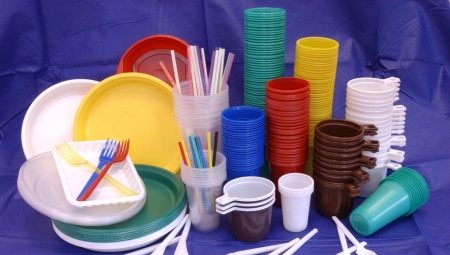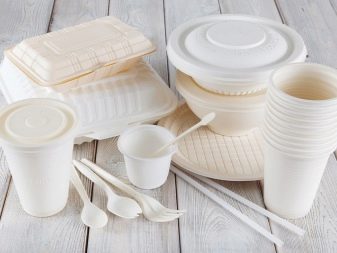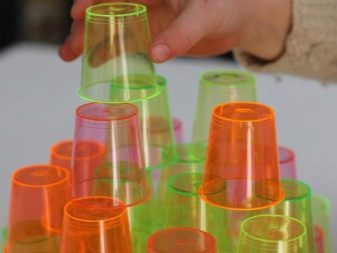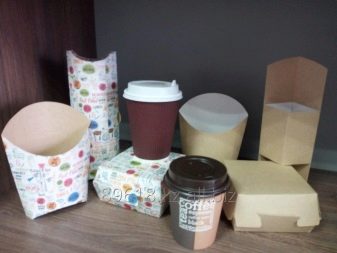Disposable tableware: what types are there and can they be reused?

Disposable tableware is indispensable for picnics, organizing tourist trips, as well as when celebrating children's birthdays. However, in recent years, environmentalists' statements about the dangers of such dishes have become more frequent, moreover, in the EU countries this year a law was passed banning plastic dishes - it will come into force in two years. Let's figure out what disposable cutlery is and is it so great harm to the environment and human health.

Appointment
With the advent of disposable tableware in stores, organizing picnics, hikes and small trips has become much easier and more convenient.
Plastic devices are widely used for birthdays, corporate events and other informal events.
The modern industry offers a wide selection of similar utensils for soups, main courses, salads, as well as drinks:
- plates and bowls;
- a variety of cutlery - forks, spoons and even knives;
- glasses and cups - they can be with or without a lid;
- additional accessories - straws, stirrers and skewers.

There is no exact data on the creator of disposable tableware. According to one version, it was invented by a poor student, to whom an accidentally broken glass was included in the bill in a cafe. According to other sources, the creation of disposable tableware began to be thought about after the publication by Dr. E. Davidson of the results of a study related to the peculiarities of using aluminum plates and spoons in school canteens. The conclusion of the physician was obvious - it is the quality of the dishes that causes the increased level of poisoning.


The very first disposable cup was made of paper and was shaped like a cone. Such a product was invented by the American journalist Moore, however, such a product turned out to be not particularly successful. Cardboard, even the densest, cannot hold water. However, the idea was picked up by other entrepreneurs and after a few years consumers were presented with perfect dishes, which can be safely considered a "pioneer" - it could hold liquid food in it, it could be placed on the table and, in terms of its external and operational parameters, it resembled the current dishes ...
In 1910, the production of such products became mass, and the demand for tableware reached its peak with the development of fast food chains - this is about the 50s. last century.


Advantages and disadvantages
Over the long years of existence of such products, no consensus has been developed about the advantages and disadvantages of disposable tableware. The advantages include the following characteristics.
- Safety of disposable tableware - unlike glass and porcelain, it cannot be broken and injured by fragments.
- Aesthetics - these days plastic dishes have a rather attractive appearance, they are presented in a wide variety of shades and prints, they can have thematic patterns, unusual textures, inclusions of foreign materials are allowed. In some cases, it is possible to manufacture according to an individual project.
- Heat resistance - under the influence of elevated temperatures, the physical and operational properties of the material remain unchanged, deformation and changes in the chemical composition of the substance do not occur.
- Versatility - Disposable tableware can be used for both hot and chilled food.
- The ability to use for storing food in the refrigerator, as well as for heating and cooking in a microwave oven.
- Some categories of disposable tableware are frost-resistant, which allows them to be used during winter hikes, as well as for storing food in the freezer.
- Durability - product deformation occurs only with a strong impact or due to the action of a flame.
- Resilience - Applies to items such as knives and forks. These features allow you to effectively cut and prick food without the fear of ruining your cutlery.
- Light weight, compactness - thanks to this property, the dishes are convenient to take with you on hiking trips.
- Resistant to acids and fats.
- Wide range of designs.
- Low cost.


The main disadvantage of disposable tableware is associated with its environmental friendliness. Obviously, most of these cutlery is made of plastic, which decomposes for more than 100 years, thereby polluting the environment, environmentalists even coined the term "plastic pollution".
Today, the problem is so acute that in the EU countries not so long ago even a law was passed prohibiting the use of disposable tableware.


Moreover, this disadvantage concerns almost all types of products, even paper ones. Just think about it: paper by itself is not capable of retaining liquid so that the glass can be used for its intended purpose, it is covered with liquid plastic, which, again, once discarded, will decompose for centuries, releasing methane and other harmful substances.In our country there is no such bill, so plastic will remain on store shelves for a long time.


Materials (edit)
Disposable tableware made from a wide variety of materials:
- cardboard covered with liquid plastic;
- the plastic itself;
- foamed polystyrene.
There are craft, parchment and foil cutlery, but the following types of products are most often used.


Plastic utensils
This concept hides dishes made of polypropylene, as well as polyvinyl chloride, polyethylene terephthalate, LDPE and HDPE, polycarbonate and other types of plastic.
Products made from these materials are versatile, highly hygienic, dense and low in cost.
Today, such dishes are widely represented in a variety of design options. and is commonly used at home, office, coffee shop, travel and family gatherings.
However, it was not without its drawbacks. First of all, these include the inability to heat such dishes and store food in it for a long time. Further, plastic is difficult to recycle, as ecologists say - this casts doubt on the prospects for the distribution of such dishes in the future.


Paper utensils
In terms of popularity, such cutlery is in no way inferior to plastic. Cardboard plates and glasses are made from paper and parchment, and craft packaging for food is also made from paper. Such dishes are common in small eateries, fast food points of sale; they are indispensable for setting the table at children's parties. Such utensils are safe and therefore, even if the baby drops such a plate, it will not cause him any damage or injury.
Paper cups are made from thin cardboard, and the outer surfaces are laminated to prevent wetting when in contact with hot and cold liquids.

In addition, the coating protects a person from burns if there is a hot liquid in the dishes.
The advantages of such dishes include:
- ease;
- practicality;
- reliability;
- hygiene;
- low cost.
When heated, such devices do not emit harmful substances and carcinogens, but due to the synthetic coating they have a long decomposition period, therefore they are unsafe for the environment.


Bio glassware
In order to reduce the harm associated with the disposal of plastic, the so-called biodegradable tableware was invented, which is made from natural materials: corn starch, sugar cane and bamboo with the addition of all kinds of food additives.
The main distinguishing feature of such devices is that they are completely safe for human health and the environment.

In addition, such dishes have many advantages for the buyer:
- light weight;
- ease of use;
- increased strength;
- the ability to withstand temperatures up to 20 degrees;
- grease and water resistance.
Complete decomposition of such kind of dishes takes 4–5 months.


Wooden utensils
Eco-friendly disposable tableware made of wood is not widely used - it is mainly used in specialized health food cafes.
The undoubted advantages of such utensils include:
- naturalness of the material;
- strength;
- aesthetics;
- environmental Safety.
The disadvantages include the high cost.


Design options
When disposable tableware first appeared on the shelves of our stores, it was presented exclusively in white solid colors. The design has changed over time, and today you can find plates, glasses, forks and spoons of various shades - black, red, orange, yellow, pink and blue, they can be matte and transparent, monochrome or printed.


The most popular decor trends for disposable table sets.
- Making stylish cups with large images or company logos - this makes the dishes especially relevant at corporate parties, trainings and seminars.
- Expanding the range of colors - probably at least half of disposable plates are purchased today for table setting at children's parties. That is why it has recently become fashionable to produce such dishes with patterns depicting heroes of your favorite cartoons, and there are plates "boyish" and "girlish".
- Cups with lids - this is one of the latest trends, such additional items are indispensable for small food outlets selling coffee, juices, cola and other takeaway products. As a rule, the lids are made colorless or whitish, while the cups themselves look quite elegant. Very often there is a tube in the kit.
- In recent years, disposable food containers have been gaining popularity - these can be containers and lunch boxes made of cardboard or plastic. As a rule, they are made completely transparent, but in recent years there has been a tendency to decorate packages with a pattern that increases appetite.


Manufacturers overview
Disposable tableware is in consistently high demand, so the production and sale of such products has been and remains a highly profitable business, at least in our country.
For many years, Italian devices were in the lead on the market, but today domestic brands have appeared in Russia, the quality of their products is in no way inferior to the famous European premium products. Among the most popular brands:
- enterprise "Mystery";
- "Tsar-Packing";
- "A source";
- Unifol;
- "Alkor";
- GC "Opticom".


Criterias of choice
Any items that come into contact with food must necessarily meet certain requirements, disposable tableware is no exception.


Such products must meet hygienic and sanitary standards and have special marking.
- It is advisable to choose dishes according to GOST, not TU. The fact is that the study of technical conditions often allows manufacturers to "omit" a number of important requirements that are spelled out in the current GOSTs.
- When choosing dishes, be sure to sniff - you should not smell any chemical odors. If you are going to buy colored dishes, it will be useful to rub it with your fingers - if it leaves a print on your hands, immediately refuse to buy.
- When choosing the right cookware, it is very important to pay special attention to the labeling of the offered products - it can tell a lot about the features of using the cookware. If the label is missing, do not risk your health.
- For hot coffee or tea, you should opt for paper cups, since drinking hot plastic drinks is fraught with a deterioration in well-being. It should be noted that plastic glasses are also not intended for drinking alcohol - when interacting with alcohol-containing components, plastic begins to release chemicals that can cause toxic damage to the body.
- Examine the packaging - there must be a small sign on it depicting a fork with a glass or glass - this symbol means that you can eat from such dishes, but if the icon is crossed out or not at all, then the material is not suitable for food products.
- For cold drinks, it is better to use polystyrene devices - it is denoted by the letters PS or the number 6. These plates and glasses are denser than polypropylene ones, and it is much easier to cling food pieces with forks and spoons made of this material. Keep in mind that when heated, such dishes deform and begin to release a highly toxic component - styrene, so the material is suitable exclusively for cold snacks and cool soft drinks.
- The numbers 2 and 4 or the letters LDPE (LDPE) denote polyethylene - it is strong, therefore it is most often used to make bottles and bags, as well as mugs.
- Dishes made of polypropylene are marked with PP symbols, they are optimal for hot products heated to 100-110 degrees, suitable for heating in the microwave, but contact with alcoholic beverages remains undesirable.
- The safest is considered to be dishes with the PET marking, but the devices marked with the letters PVC or PVC, on the contrary, are quite dangerous for food use.


Important: keep in mind that when buying, you cannot be 100% sure that the material does not contain toxic components, since in accordance with the accepted standard, only the type of plastic is indicated.
That is why try to choose only the product of trusted manufacturers or shop in large supermarkets that value their reputation.

Is it reusable?
Reuse of disposable tableware is unacceptable. The fact is that the protective layer is usually quite fragile and often after the first application is damaged - this leads to the fact that harmful compounds can enter the body along with food.

The prohibition can be indicated by the markings of the dishes.
- PET or the number 1 directly indicates the inadmissibility of reuse, since under the influence of oxygen, the oxidation of the material begins and the release of harmful substances. For the same reason, it is not recommended to reuse products marked on the packaging with a triple or a seven - with prolonged exposure to components released over time in the body, pathological processes can begin, up to oncology.
- But dishes with markings 2.4 and 5 can be used - they are made from potentially safe substances, however, only chilled food and drinks are allowed to be stored in it.

However, the danger of the release of toxic components is far from the only one that awaits when disposable tableware is reused. The fact is that such cutlery is quickly scratched and microcracks form on the surface. Even if you try hard, you still won't be able to wash them until they are completely sterile. As a result, an ideal environment for the reproduction of pathogenic microflora is formed here.
Drinking and eating out of plastic utensils a second time, some researchers have argued, is like licking a toilet cushion.
Just think: this dish has already been with you on the way, the sun was shining on it, road dust adhered to it, you grabbed it with your hands, and not very clean - better boldly part with it and do not give microbes an extra chance to get into your body.

In this video, you will get acquainted with the production process of disposable tableware.








